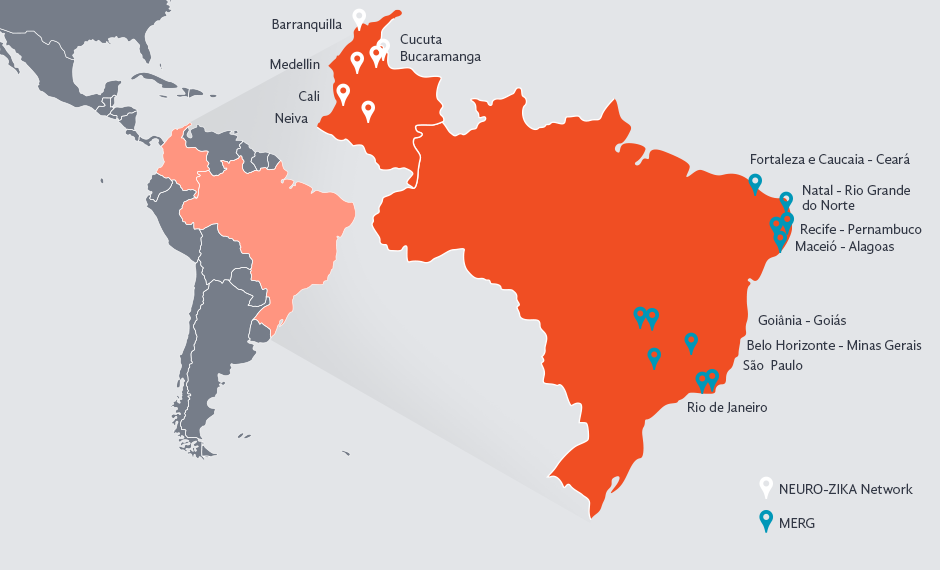Key Results & Achievements
MERG’s task at the outset of ZikaPLAN was to establish two multicentric cohorts: one of pregnant women with an episode of rash during pregnancy and the second, a cohort of children with suspected prenatal exposure to Zika virus (ZIKV).
“We are examining the social component and impact on families where a child is affected with microcephaly to understand how the quality of life is affected; the impact on divorce and unemployment but also on everyday loss of sleep, depression and difficulties with child care.”
Prof. Laura Rodrigues, London School of Hygiene & Tropical Medicine
Congenital Zika implications for pregnant women
Out of the women who were identified with rash during pregnancy, a substantial proportion of them had detectable virus at the time of testing. Additional women were identified as ZIKV-positive by immunological testing. These data were used to determine the attack rate of Congenital Zika Syndrome (CZS) by gestational week of infection and the prevalence of adverse birth outcomes associated with Zika infection in pregnancy. Moreover, a manuscript describing a novel algorithm for defining cases of maternal ZIKV infection in pregnancy and its application to the cohort study was accepted by PLOS Neglected Tropical Diseases.
Given the decline in Zika incidence, the active recruitment of pregnant women with rash was discontinued in 2017. Instead, benefiting from possibly the largest cohort of affected children in Brazil, ongoing studies and follow up of neonates were intensified.
Congenital Zika implications for neonates
Children with microcephaly and other clinical manifestations of CZS were monitored over the first three years of life and the data used to describe the full spectrum of CZS including neurodevelopmental milestones.
A task force of clinical specialists carried out the follow-up evaluation and monitoring of the wellbeing of these children. Significant results from neuroimaging and Bayley III testing in the Rio de Janeiro-based cohort indicated higher odds of having a Bayley-III score 2 SD below the mean among children with abnormal versus normal brain imaging. These findings were published in the New England Journal of Medicine.
Further to this, functional impairments (feeding behaviours and a worsening of nutritional status) during the critical first 1000 days of development were observed among children with ZIKV-related microcephaly and these results were published in Nutrition Journal.
The research carried out also indicated that, even in the absence of microcephaly, a subset of infants with prenatal ZIKV exposure had impaired motor function compared with their neurotypical, unexposed peers. These results were published in JAMA Network Open.
Evaluation of the social and economic impact
A further subset of maternal-child dyads was evaluated to estimate the social impact and costs (e.g., on livelihood, occupation, mental health, and health service needs) of raising a child with congenital exposure to ZIKV.
In-depth qualitative interviews were conducted in Brazil with healthcare professionals, men and women in the community, pregnant women and mothers and caregivers of children with CZS. Substantial economic impacts of CZS were noted at household, population and societal levels. Direct costs borne by affected families and costs to the healthcare system were shown to be significantly higher for children with CZS than for those unaffected by CVS.
Greater levels of depression and anxiety were noted among the caregivers of children with CZS, and, in a context of widespread social and economic deprivation, these caregivers reported that having a child with severe disabilities was just one of many difficulties in their lives. They also indicated major gaps in the health system and women reported a lack of the information and services (including access to legal abortion) needed to adequately control their fertility.
Moreover, in the absence of established evidence about CZS, healthcare professionals struggled to provide information and care for the children, and, in turn, caregivers expressed a lack of trust in these professionals. Trust and support came mostly from peer groups, especially from other mothers with affected children.
Cohort data from the MERG Working Group have been used to inform the harmonized Latin American-wide guidelines for the management of severe illness caused by Zika and have contributed to the joint statistical analysis with ZikAlliance and ZikAction. Findings have also provided support for the development of a platform for future vaccine and drug studies.
Close collaboration with the REDe Research Capacity Network was important to bolster scientific capacity in Brazil and to prepare for any future emerging severe infectious threats.

Where MERG and NEURO-ZIKA are active
Participating Organisations
Group leader: Dr. Elizabeth B. Brickley, London School of Hygiene & Tropical Medicine
- Umeå University
- Queen Mary University of London
- Ulster University
- Associação Técnica–Científica de Estudo Colaborativo Latino Americano de Malformações Congênitas
- Fundação Oswaldo Fiocruz
- Universidade de Pernambuco